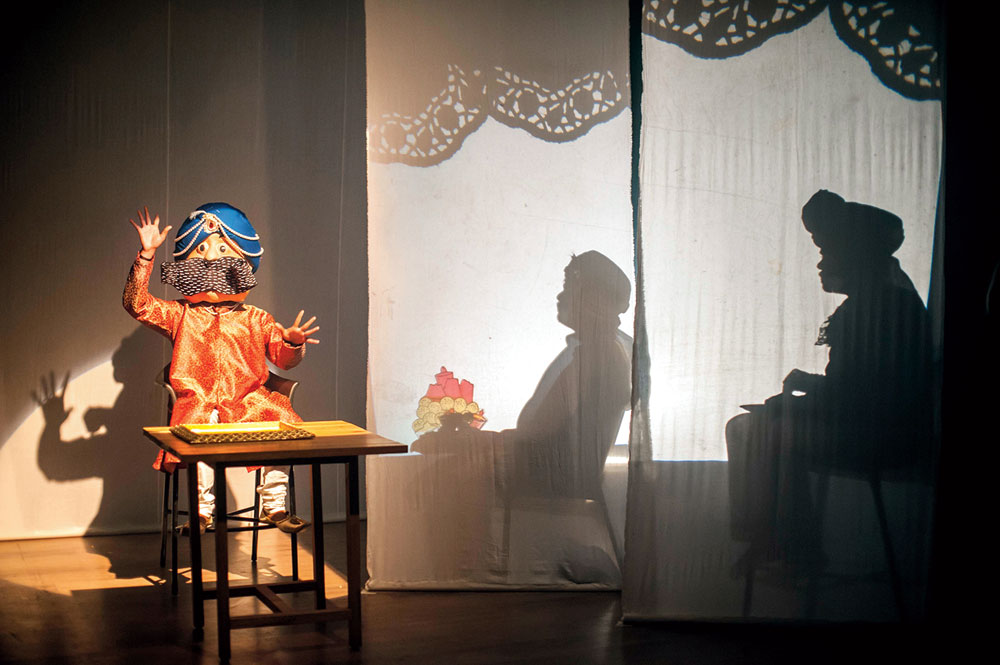
Living up to its title, there is much mischief in the story with the 30-year-old king of Mastipur Sourced by the writer
A very young audience giggled gleefully and, alternately, sat spell-bound as the Anurupa Roy-directed puppet drama, The Maharaja of Mastipur, unfolded before their eyes. Based on a book published by Crossover Media and Design Pvt. Ltd and brought on stage by its initiative, Guppy Theatre, the play used a variety of puppets, mixed media, music, dance and interaction with an enthusiastic audience at Mumbai’s Prithvi Theatre.
Living up to its title, there is much mischief in the story with the 30-year-old king of Mastipur, a mythical kingdom in Rajasthan, being a compulsive prankster who spares nobody, not even the king and queen of England, much to the annoyance of his mother, the rajmata, who chides him like she would a child. This, of course, is lapped up by the children, who are tickled pink that an adult can be so naughty and scolded in this manner.
Apart from the maharaja’s pranks, what enthrals the viewers is how a bare stage with just a few white screens transforms into a grand palace one moment, a magical world in another and a jungle with trees and wild animals in yet another. The much-awarded Roy uses shadow puppetry and screen projections to transport the audience to a fantasy world in which a tiger is given a smart haircut before being togged up in a tuxedo and then shown sitting at a table sipping tea with the maharaja, very propah and upright, where English royalty partakes of a feast with dessert appearing before it in a moving toy train, and where a magician entertains with a fabulous play of illuminated orbs.
Sometimes, children from the audience are invited on stage to rub shoulders with the large-headed maharaja and become a butt of his playful pranks, thus becoming a part of the story and heightening the excitement and sense of anticipation in the auditorium. Which is exactly what Guppy Theatre set out to achieve. Its CEO, Cyril-Vincent Michaud, points out, “At Guppy Theatre we don’t simply tell stories. We show how stories can be transformed by the medium in which they are told and by those who listen to them… we show that thinking differently is not only possible but lots of fun.”
Adding to that, Roy elaborates, “It is a show where kids can see stories inspired by the Maharaja book series live on stage. It is a unique mix-media experience, which allows the kids to interact with the characters on a dynamic stage that has multiple projections on multiple shadow screens. The puppeteers wear large masks that increase their stage presence and help make their characters more engaging.”
For those who had only, perhaps, seen the kathputlis of Rajasthan or the glove puppets of Bengal and Odisha, The Maharaja of Mastipur opened up a whole new world of puppetry. That puppets could be combined with stagecraft in this enchanting manner was truly a revelation.
Roy was all of 10 when she got drawn into this amazing world — when she saw Dadi Pudumjee stage Circus using umbrellas as puppets and Ranjana Pandey’s outdoor show of Neeli Pari, at the Crafts Museum in Delhi. Completely mesmerised, she decided this is what she would like to do when she grew up. So, even as she did academics, Roy learnt the craft of puppeteering from veterans in the field, such as Varun Narain and Ranjana Pandey. By the time she was in her third year of college, she had started her own puppet theatre company called Katkatha. Ever since, she has been telling stories through puppets.
However, Roy’s stories are not just fantasy tales about kings and queens. Influenced by Ranjana Pandey, Roy uses the art of puppetry to spread awareness about serious issues like water scarcity, drugs, forced migration, AIDS et al; and as therapy in juvenile homes and conflict-ridden zones like Kashmir and Manipur. Roy, who acquired several diplomas from Sweden and Italy in puppet theatre and worked with Dadi Pudumjee thereafter, also stages Shakespeare and tales from Indian history and mythology through her multifaceted puppets.
Her repertoire is vast and varied; but even as she stages shows for adults, the child in her continues to be very much alive and she can bring the house down for children through pure fun and games as well, as was evident at the staging of The Maharaja of Mastipur.












